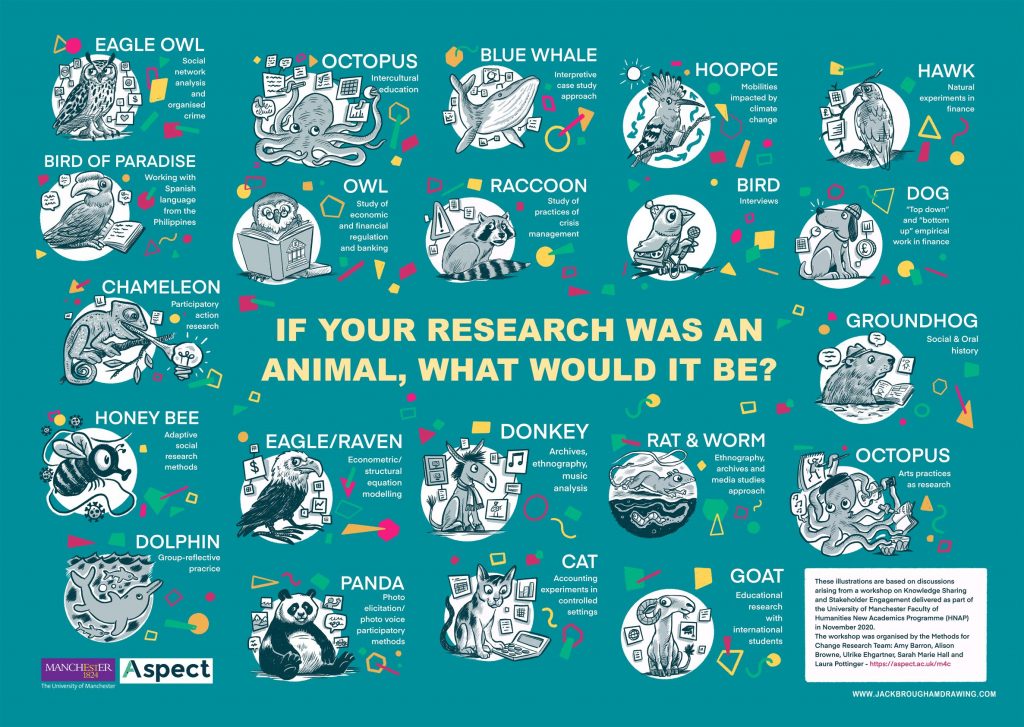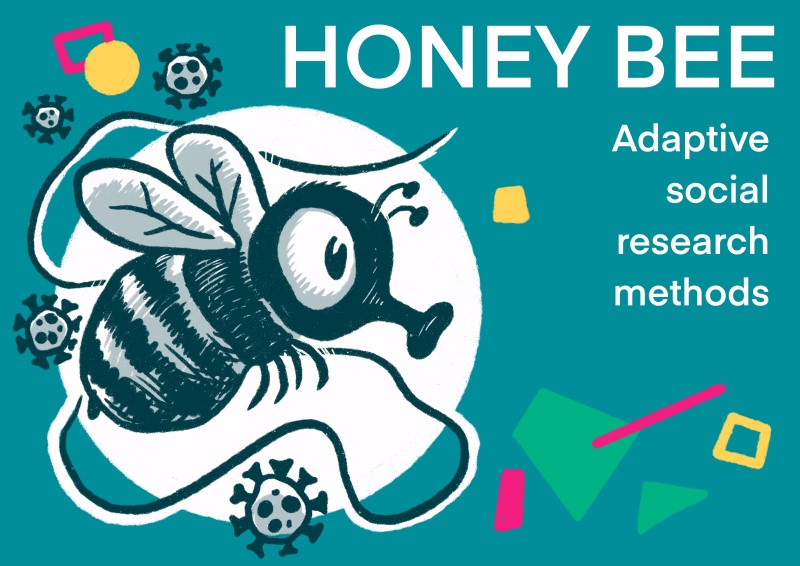We hope this feature will give other researchers useful hints and tips on how to work with creativity, as well as ways to share their research in accessible forms. It will also provide an insight into the creative methodological tools we employ within the Methods for Change project to elicit meaningful conversations about diversifying research methods and promotion and transformational change.
Creativity and research engagement
At most academic institutions, including at the University of Manchester, early career academics are required to undertake foundational sessions that provide support and training to help them develop their skills as researchers, teachers and innovators. These courses are often delivered by academic staff as well as professional support services, to give a real flavour of academia in the round. In November 2020, the Methods for Change team were invited to design and deliver a session for the recently revamped Humanities New Academics Programme – a course that some of us had undertaken in the past – on the topic of effective knowledge transfer of research. Given how close this sits to the motivations and aims of Methods for Change, we took on this task with relish. Nevertheless, we were mindful of the challenges of delivering meaningful training, online and in the middle of pandemic. We therefore agreed that the session should promote enjoyment, collaboration and engagement, and provide a comfortable learning space for all involved.
Our session, entitled ‘Research Methods for Social Change: Sharing Knowledge, Engaging Stakeholders’, was delivered on Monday 16th November by the full project team, and attended by over 20 academics from across the faculty. Opening with an introduction to the project, our approach to research engagement, impact and knowledge transfer, as well as in a more general sense, the session offered opportunities for colleagues to discuss the different creative ways they could communicate their research, in terms of outputs, audiences and legacies. To create a supportive environment, attendees were twice arranged into break-out groups for more intimate discussions, each chaired by a Methods for Change team member.
During the session we also introduced colleagues to some of our project’s creative methodological and engagement techniques, replicating them for the purposes of the training. Our aim was to get attendees thinking in creative ways about research from the offset. To do this, we split into small groups to discuss answers to the following question, provided to attendees a few days in advance:
If your method / approach to researching was an animal, what animal would it be?
This is a line of creative questioning used in our project interviewing with academics on their methods for change, and is inspired by two key sources. Firstly, the work of Cook et al. (2009), whereby in their research on mortgages they asked participants ‘if your mortgage were an animal, what would it be?’, in order to elicit details about how people related to their everyday finances. We were also inspired by Sarah Butler’s approach to exploring lay understandings of English Devolution and her creative outputs, with a similar question posed to participants: ‘if Devo Manc was an animal, what would it be?’.
Our question was also accompanied by some prompts – why did you choose this animal? What characteristics does it have, how does it behave, what does it interact with? – so as to flesh out the creative possibilities of the technique. We took notes on the menagerie of animals that were discussed in each group and passed these to talented illustrator Jack Brougham, who created the poster below.

Meeting the Animals
We asked participants in the session to share the stories behind their chosen animals, as featured above, and to describe the link to their methods and approach. This also gives us a chance to take a more detailed look at some of the illustrations.
Stephanie Sodero, Lecturer in Responses to Climate Crises at the Humanitarian and Conflict Response Institute, University of Manchester, picked the hoopoe to represent her ‘follow the thing’ research approach. Here she explains why:

“I research how global medical supply chains are impacted by a changing climate. I chose the hoopoe, a bright migratory bird, to capture the transnational and difficult-to-trace mobilities entailed in my work.
The hoopoe migrates annually between Africa and Europe, sometimes landing in the UK by accident, capturing how disruptive events like severe weather sidetrack supply chains.
In some cultures, the hoopoe is a bad omen – a reminder that injustices often underpin the global movement of goods. I appreciate, however, that the bird is colourful and eclectic, elements that I try to bring to my academic research and writing.”
Robert Meckin, Presidential Fellow in Sociology at the University of Manchester, also offered his thoughts on his chosen animal – the bee – and on the session more generally:

“The bee is a model social insect of ecological importance. They work together, work hard for the hive and provide important duties of pollination. And, they’re a symbol of Manchester. I’m currently leading an NCRM project work stream that involves knowledge exchange workshops with research communities to share their experiences and help create resources for the wider research community to support work within the context of Covid-19-related social restrictions. This, in turn, will help support social researchers to continue engaging with stakeholder and participant communities. So, method and bee seemed harmonious.”
He further reflects:
Being in Manchester, I predicted more bees. Instead, I was struck by the range of method metaphors. To categorise a few, there were pandas, bees and dolphins as relational and ecological methods; anteaters, racoons, rats and ground hogs as grounded, detective methods; donkeys and dogs as hard working methods; and birds of prey as overview-focus methods. What I enjoyed most was not so much the surprise of some (two octopuses) or species specificity (a hoopoe), but the unfolding realisation of how, as they explained how their animal and method were linked, other researchers understood their methods and how they fitted within their wider research worlds. An engaging and illuminating session and one I recommend if it’s run again.”
We really enjoyed delivering the session, and hearing all about people’s animals-as-methods. In future work, we hope to write more about this approach, and to share creative representations of all the animals discussed within our interviews, too. For now, we will leave readers pondering about what their animal would be.




